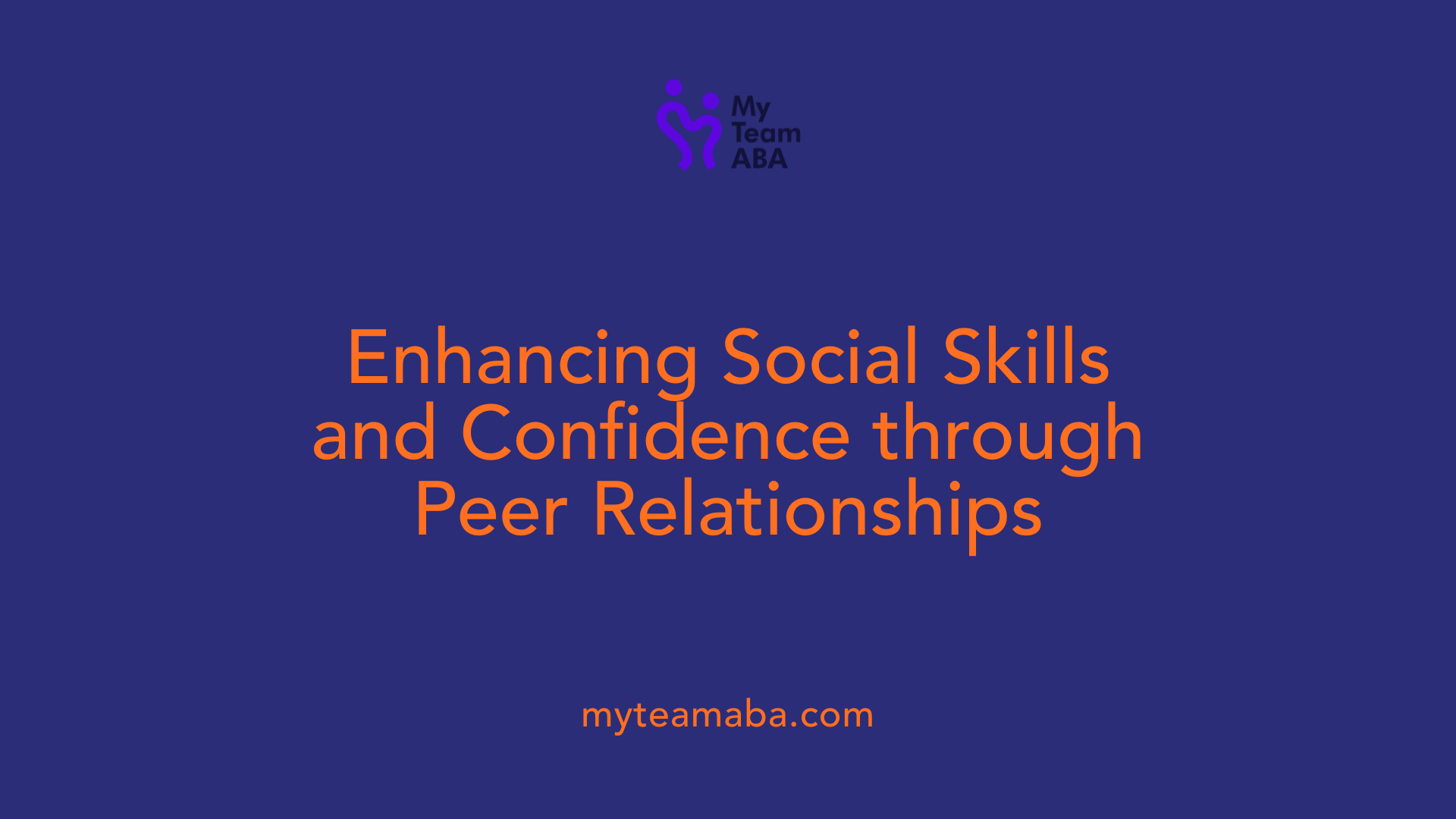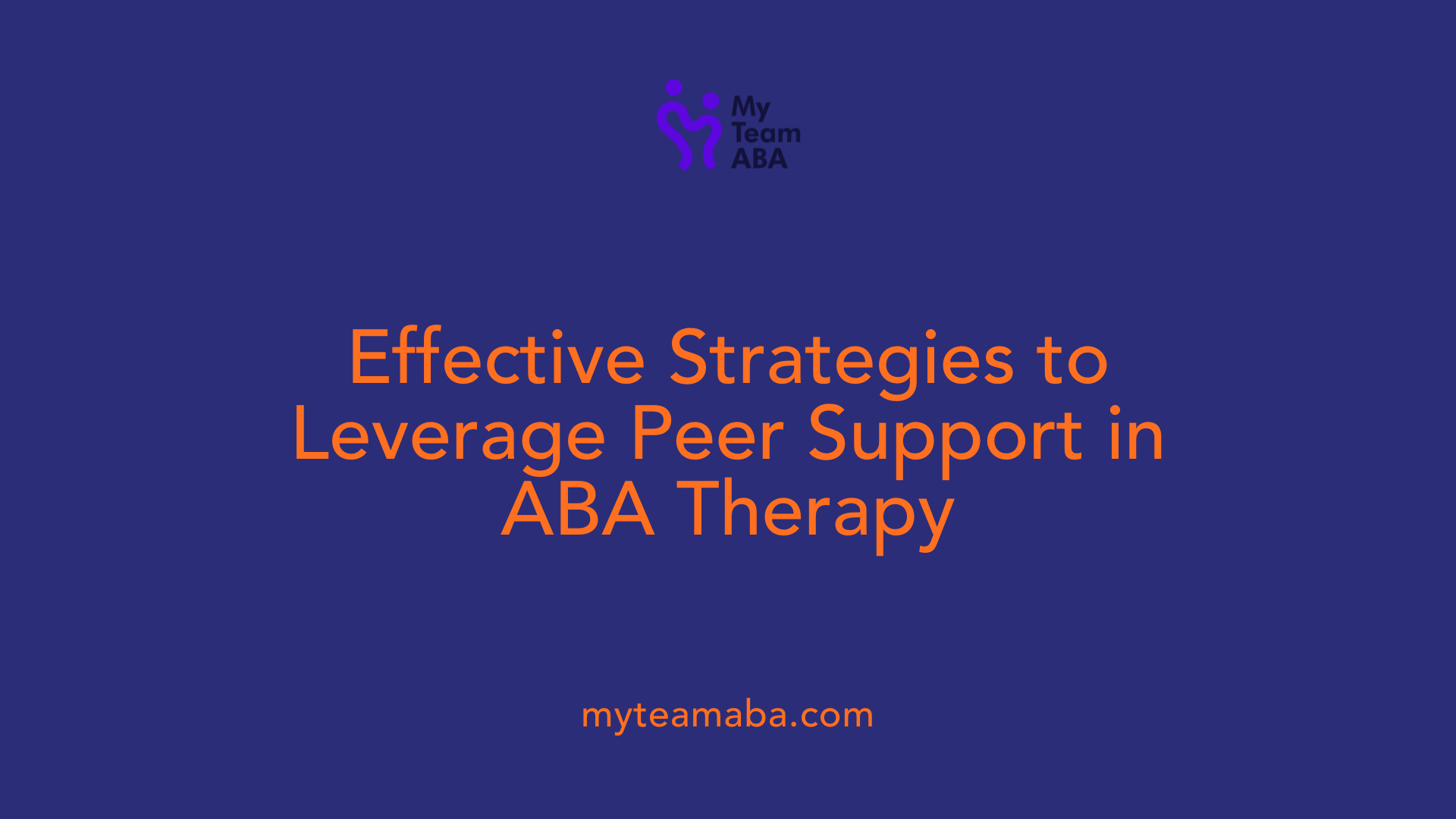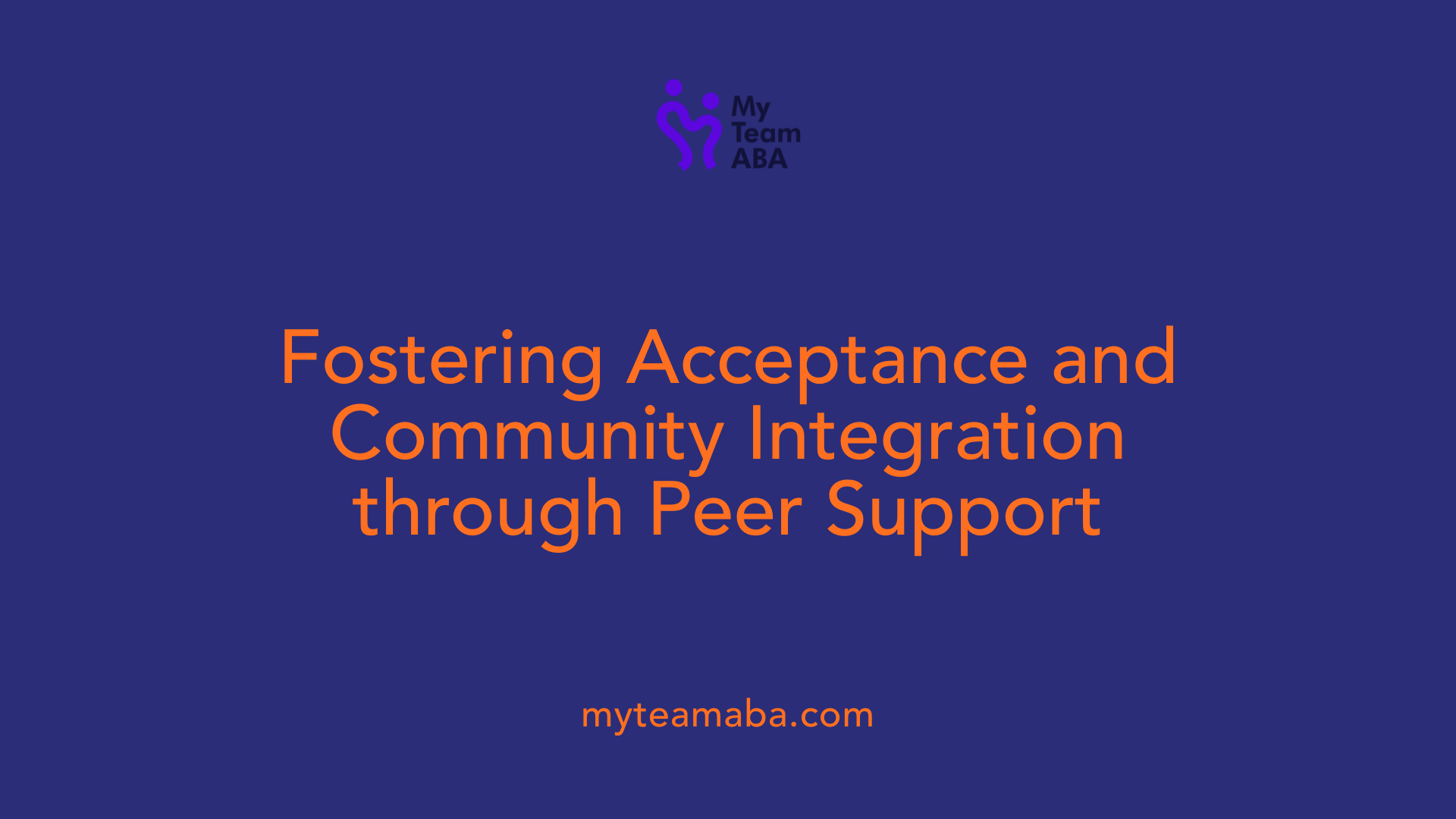The benefits of using peer relationships to encourage progress in ABA therapy
November 2, 2025
Unlocking Social Potential: How Peer Relationships Accelerate ABA Progress

Harnessing the Power of Peer Interactions in Autism Therapy
In the realm of ABA therapy, peer relationships have emerged as a pivotal element in fostering meaningful, lasting progress for children with autism. These relationships provide naturalistic, engaging opportunities for social skill practice and emotional development. This article explores how structured peer interactions complement traditional ABA strategies, enhance social inclusion, and promote overall developmental gains.
The Role of Peer Relationships in ABA Therapy Progress

What are the benefits of peer relationships in encouraging progress within ABA therapy?
Peer relationships are instrumental in advancing progress for children undergoing ABA therapy. Engaging with peers offers children valuable opportunities for real-life social interactions, which are essential for developing social and communication skills.
Structured group activities, such as role-playing, cooperative games, and peer-mediated interventions, help children observe, imitate, and practice key social behaviors. These include turn-taking, sharing, and understanding social cues, which are all vital components of social competence.
Building friendships through peer interactions boosts children’s self-confidence and emotional well-being. Feeling connected and accepted encourages more active participation in social settings, reinforcing positive behaviors.
Participation in peer-based groups not only enhances social skills but also promotes independence and generalization of learned behaviors in natural environments. These interactions serve as a bridge, translating therapy skills into everyday situations.
Overall, fostering supportive peer relationships within ABA therapy creates a motivating and enriching environment that accelerates social development, improves communication, and supports long-term community integration.
Supporting Social Skills Development through Peer Interactions

How do peer interactions support social skills development in children with autism?
Peer interactions are essential for developing social skills in children with autism. These interactions offer real-world opportunities for children to practice important social behaviors like initiating conversations, sharing toys, taking turns, and responding appropriately to others. Engaging with peers allows children to learn these skills in a natural context, which supports better understanding and application.
Structured peer-mediated interventions and social skills groups enhance these interactions. Therapists and educators often use targeted training, role-playing, modeling, and reinforcement techniques to encourage positive peer exchanges. These approaches help children develop their ability to sustain social exchanges, improve empathy, and understand social cues.
In addition, visual supports and pairing children with socially skilled peers can promote better engagement. Creating an environment that supports positive interactions helps reduce peer stigma and fosters meaningful friendships.
What are natural and real-life opportunities for practicing social skills?
Real-life settings like schools, community centers, and home environments provide rich opportunities for children to practice social skills. These settings allow children to generalize skills learned in therapy to everyday situations, such as playing on the playground, joining group activities, or participating in family gatherings.
Structured activities with clear goals, combined with spontaneous opportunities, enable children to develop confidence and social reciprocity. Parents and caregivers play a crucial role in creating continuous practice opportunities and reinforcing social behaviors learned during therapy.
Overall, combining structured interventions with everyday experiences maximizes social skill development, promoting greater social participation and integration for children with autism.
| Aspect | Description | Additional Details |
|---|---|---|
| Peer Interaction Benefits | Supports social skill development | Increases communication, empathy, and social reciprocity |
| Techniques Used | Modeling, reinforcement, role-playing | Enhance engagement and learning |
| Settings | Schools, community, home | Provide real-world practice |
| Goals | Greeting, sharing, turn-taking, emotional expression | Encourage positive social behavior |
| Parental Role | Reinforce skills and facilitate interactions | Promote consistency and generalization |
| Outcomes | Improved peer relationships, reduced stigma | Better social integration |
Fostering peer interactions through structured activities and everyday experiences helps children with autism develop vital social skills, leading to improved social participation and a greater quality of life.
Techniques and Strategies for Leveraging Peer Relationships in ABA

What strategies can be used to leverage peer relationships to enhance ABA therapy outcomes?
Integrating peer relationships into ABA therapy can significantly boost social skills and generalization of learned behaviors. One effective approach involves structured peer play sessions and peer-mediated interventions. These activities encourage children with autism to interact, cooperate, and share in a natural setting, making social exchanges more relatable and engaging.
Role-playing exercises are also valuable. They create a safe space where children can rehearse social scenarios, recognize emotions, and practice appropriate responses. These exercises help children understand social cues and improve their ability to initiate and maintain conversations.
Positive reinforcement is central to all these strategies. Praising children when they use social skills, such as eye contact or sharing, encourages repetition and increases motivation. Using social signals, such as clapping or verbal praise, reinforces successful social interactions.
Visual supports, like charts or cue cards, combined with clear routines, help children anticipate social activities and reduce anxiety. Gradual exposure to peer groups, starting with smaller or familiar groups, builds confidence and social competence over time.
How can structured approaches promote skill generalization?
Structured peer activities nurture generalization by providing consistent, predictable environments for children to practice social skills across different settings. Group activities that are part of the therapy, whether at home, school, or community, help children transfer learned skills to real-world situations.
Using role-playing as part of a broader curriculum prepares children for various social challenges they may face outside therapy sessions. Training on specific skills like turn-taking, respecting boundaries, and expressing emotions strengthens the child’s ability to navigate diverse social scenarios.
Furthermore, ongoing collaboration between therapists, parents, and teachers ensures that social skills are reinforced consistently across environments. Visual supports and clear routines serve as prompts that guide children in applying these skills independently.
Ultimately, combining these methods fosters meaningful social relationships and supports the broader goal of social inclusion, helping children participate actively in their communities.
| Strategy | Description | Benefits |
|---|---|---|
| Peer-mediated intervention | Training peers to model and reinforce social skills | Improves natural social interactions |
| Role-playing | Practice of social scenarios in a safe setting | Builds confidence and response options |
| Reinforcement strategies | Use of praise and social signals to encourage behavior | Motivates continued social engagement |
| Visual supports | Use of visual aids for routine and cueing | Increases understanding and independence |
| Gradual Exposure | Stepwise introduction to peer groups | Reduces anxiety and builds familiarity |
This comprehensive approach, combining structured activities, reinforcement, and peer involvement, helps maximize social development in children participating in ABA therapy, fostering meaningful social integration and emotional growth.
Evidence Supporting Peer Integration in Autism Interventions
What evidence supports the integration of peer relationships into autism interventions?
Research into autism interventions highlights the significant role of peer relationships in improving social skills and promoting social inclusion. Peer-mediated interventions (PMIs) are a primary example of this approach, showing remarkable success in natural settings such as schools.
Studies indicate that when peers are trained to interact positively with children with autism, they help promote behaviors like initiating conversations, responding appropriately, and engaging in reciprocal play. This model fosters authentic social interactions that mirror real-world situations, making learned skills more functional.
Beyond direct behavior improvements, PMIs help children with autism build broader social networks. These structured interactions increase opportunities for friendship development and reduce feelings of social isolation. For example, playdate programs and supported social activities designed to encourage peer engagement have proven effective in forming meaningful friendships.
Furthermore, research underscores the protective benefits of peer relationships. They can serve as buffers against emotional challenges and promote internalizing behavior reduction, which improves overall well-being.
Overall, the science shows that interventions incorporating peers create more natural, engaging environments where children with autism can learn and practice vital social skills. This approach not only improves immediate social behaviors but also supports long-term social integration and community participation.
| Evidence Type | Main Focus | Key Outcomes | Additional Notes |
|---|---|---|---|
| Peer-Mediated Interventions (PMIs) | Promote social initiation and response in natural settings | Increased reciprocal social behaviors, play, and communication | Studies mainly in school environments |
| Structured Playdates | Foster friendship and social reinforcement | Increased peer engagement and relationship building | Often supported by training peers |
| Social Inclusion Programs | Reduce social isolation and improve emotional well-being | Broader social networks, decreased internalizing behaviors | Highlighted as protective factors |
| Training Peers | Facilitate meaningful interactions | Higher rates of positive peer interactions and friendships | Emphasizes importance of ecological validity |
Incorporating peers into interventions offers a compelling way to teach children with autism essential social skills while nurturing genuine friendships, ultimately enhancing their participation and quality of life in community settings.
Overall Impact of Peer Relationships on Child Development in ABA
How do peer relationships impact overall progress and development in ABA therapy?
Peer relationships significantly influence a child's growth in ABA therapy by nurturing essential social, emotional, and communication abilities. Structured peer-mediated interventions are commonly used within ABA to create opportunities for meaningful socialization, acceptance, and a sense of community.
These interactions help children learn vital social cues, such as taking turns, sharing, and initiating conversations. As children practice these skills with peers, they become more comfortable and confident in social settings, which promotes better integration into their community.
Moreover, positive peer influence can support emotional resilience by reducing feelings of loneliness or anxiety often experienced by children with autism. When peers actively participate in therapy activities, they can model appropriate behaviors, helping children develop a clearer understanding of social norms.
In inclusive environments, peer interactions foster adaptability and empathy, as children learn to interpret others' emotions and assert boundaries. These skills are vital for emotional regulation and understanding social relationships.
Including peers in therapy sessions and social activities broadens the child's learning experiences, encouraging generalization of skills across different situations. It also promotes emotional well-being by building friendships, which can lead to improved motivation and engagement during therapy.
Research highlights that integrating peer relationships in ABA does not only enhance communication but also boosts emotional resilience, which is essential for holistic development. As children become more adept at navigating social landscapes, their overall progress in independence and social participation improves.
In summary, engaging peers within ABA therapy enriches social, emotional, and communication domains, supporting children in achieving broader developmental goals and fostering lasting skills for real-world settings.
Facilitating Social Engagement and Communication through Peer Relationships
How do peer relationships facilitate social engagement and communication skills in children receiving ABA?
Peer relationships play a crucial role in fostering social skills and communication in children with autism undergoing ABA therapy. One of the main ways they do this is by offering natural settings where children can practice social interactions like greeting others, taking turns, and sharing, all within meaningful contexts. These interactions serve as real-life opportunities for children to learn social cues and emotional understanding, which are essential for developing social competence.
ABA therapy often incorporates structured group activities and play that are designed around children's interests. This approach enhances motivation and encourages active participation. By engaging with peers in these settings, children develop better social awareness, empathy, and perspective-taking abilities.
Through calm, supportive peer-mediated interventions, children learn to initiate conversations, respond appropriately, and sustain interactions. Reinforcement strategies teach children to recognize positive social behaviors, reinforcing their motivation to participate.
Additionally, peer relationships help children generalize the social skills learned in therapy to everyday life. Building friendships and increasing social participation not only improve social competence but also contribute to greater independence and emotional well-being. Overall, leveraging peer interactions in ABA therapy creates a natural, supportive environment for children with autism to enhance their communication and social engagement skills, leading to improved integration into school, community, and family life.
The Significance of Peer Support and Community Inclusion

Why is peer-based social support important in therapy for children with autism spectrum disorder?
Peer-based social support plays a vital role in the overall success of therapy for children with autism spectrum disorder (ASD). It encourages natural social interactions, which are often challenging for children with autism. Programs that include peer mentorship and mediation, such as PEERS® and PMI, have been shown to boost social skills like initiating conversations, responding appropriately, and engaging in cooperative play. These initiatives help children develop social competence in real-life situations, making their social skills more functional and generalizable.
Beyond skill development, peer support offers emotional advantages. It can increase self-confidence, diminish feelings of loneliness, and improve overall well-being for children with ASD. Not only do the children benefit, but their parents also experience relief and satisfaction knowing their child is gaining social acceptance and competence through genuine peer interactions.
Creating inclusive community environments through peer initiatives helps reduce stigma associated with autism. These programs promote understanding and acceptance among peers, fostering lifelong friendships and normalizing the presence of diverse learners.
In summary, peer support programs are essential complements to clinical therapies because they emphasize authentic, mutual social engagement. They help children with autism develop independence and confidence while fostering a more inclusive society that values diversity.
How does peer mentorship impact social independence and societal acceptance?
Peer mentorship facilitates the development of social independence in children with autism by providing role models and a safe space for practicing social skills. As children learn to interact more confidently with peers, their ability to navigate social situations improves, promoting greater independence in school, community activities, and daily life.
Furthermore, peer-led activities and inclusive programs contribute to societal acceptance by normalizing interactions between autistic children and their neurotypical peers. When children with autism are included in group activities and social settings, misconceptions decrease and understanding increases, paving the way for broader societal acceptance.
Engaging peers as mediators and mentors also supports the creation of supportive networks that extend beyond therapy sessions. These networks often foster friendships, encourage community participation, and help children with autism feel more integrated and valued within society.
In essence, peer involvement in autism therapy not only enhances individual social skills but also acts as a catalyst for societal change, promoting acceptance, reducing stigma, and opening pathways for meaningful participation in community life.
Fostering a Future of Inclusive Social Growth
Integrating peer relationships within ABA therapy not only accelerates skill development but also nurtures lifelong social connections and emotional resilience. As research and practice increasingly support peer-mediated strategies, the potential for children with autism to thrive socially, emotionally, and academically expands. By fostering a culture of inclusion and mutual support, therapists, parents, and communities can help children with autism reach their full potential, fostering a more understanding and accepting society.
References
- Group vs. Individual ABA Therapy for Children With Autism
- Applied Behavior Analysis (ABA) | Autism Speaks
- Understanding ABA ASD: Key Benefits for Autism Treatment
- ABA Therapy for Kids: Helping with Friendships and Social Skills
- ABA Therapy & Its Benefits: A Comprehensive Guide
- Applied Behavior Analysis in Children and Youth with Autism ...
- Harnessing ABA Therapy for Social Skills Development in Autism
- How ABA Therapy Enhances Social Skills in Children with ASD
- Effective Strategies for Turn-Taking in Autism Therapy - Astra ABA
